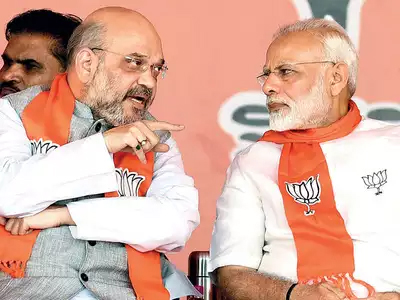
Crackerjacks from India’s West
Modi and Shah have injected professionalism in the BJP that’s out of step with the ‘chalta hai’ ways of the past
India’s West has left an ineffaceable stamp on the BJP. Prime Minister Narendra Modi and Amit Shah , the party president, do not belong to the north although Modi adopted Uttar Pradesh as a second home. The bureaucrats Modi relies on are from Gujarat. If the RSS is looking to groom a younger person as a potentate, some years from now, the odds are it would be Devendra Fadnavis , the Maharashtra chief minister.
Modi’s antipathy towards Delhi is not confined to that elitist zone that contains neo-Classical architecture with accents borrowed from India’s Mughal and Buddhist past. That’s Lutyens Delhi, named after its eponymous creator. To Modi and Shah, Lutyens Delhi is loathsome, signifying everything that’s “venal” and “uppish” about politics, although both are ensconced on its terrain and seemingly love the accoutrements. Modi and Shah have also shown impatience with the dawdling style of functioning, characteristic of the feudal North, where power politics hinges on personal camaraderie and decision making is opaque and protracted.
Nitin Gadkari brought a dose of the West’s professionalism when he became the BJP president in December 2009. He junked the 9 am (people strolled in after 11am) to 5 pm timeline the party followed and began working after sundown until the crack of dawn. Gadkari’s “system”, as the BJP’s Northerners called it, was as incomprehensible to them as was his penchant to use Mumbai patois with the cuss words and cut to the chase without the pehle aap preface. He remade the BJP’s old headquarters. The spick gave the Lutyens structure a corporate look. Because he was all about “development”, articulated in the fashion of Mumbai’s business folks, and seldom alluded to ideology and morality even in an ersatz context, Gadkari wasn’t accepted by the cadre at large. For instance, the net literates he used for the 2012 Uttar Pradesh election picked the candidates entirely through a software programme that factored in caste compositions and past poll data without considering ground realities. Sacrilege for UPites used to long-listing and short-listing nominees after protracted meetings, intrigues and brawls.
Modi formed the perfect fit between professionalising politics and adhering to the RSS-BJP’s ideology. To the thousands who sought politics as a career, he held out hope. To the Sangh’s faithful, who couldn’t divest their ambitions of weltanschauung or a fraction of it, he validated the belief that there was nothing amiss in seeing politics as a vocation.
Rajnath Singh headed the BJP when Modi became the PM. Rajnath wasn’t the partner Modi would have wanted. Soaked in UP politics, he was used to dithering on decisions unless the outcome meant getting even with an adversary. When Atal Bihari Vajpayee wanted Kalyan Singh out of the BJP, Rajnath was the UP party president. He lost no time in serving his long-time rival as how-cause notice. Yet in 2013, at the famous BJP national executive meet in Panaji, when it was more or less clear that Modi would head the campaign committee before the 2014 election in a gradational process to eventually anoint him as the PM candidate, Rajnath waffled. He faced stiff opposition from veteran LK Advani and was afraid to bite the bullet. Somebody there counselled Rajnath to be “brave”, conduct himself like a “Rajput” and announce Modi’s name. He did.
Modi sensed Rajnath’s pehle aap predicament wouldn’t be in synch with his notion of the BJP as a get-up-and-go enterprise. In 2015, shortly after Rajnath was appointed the home minister, he made way for Shah to head the BJP. Modi beamed when his protégé-turnedfirmest ally took the baton at a spectacular function. The hallmark of the Modi-Shah regime is the ability to celebrate victories at every level—from panchayat to assembly elections—and downplay defeats, even those as conclusive as the ones in Delhi and Bihar. Indeed, Modi and Shah were focussed on destabilising the Delhi and Bihar governments from day one. Arvind Kejriwal, the Delhi CM, confronted the duo, paid a heavy price at times but managed to pursue and execute his core political agendas despite the deterrents. Nitish Kumar , the Bihar CM, older and perhaps more pragmatic than Kejriwal, didn’t have an appetite to fight Modi and Shah. He dumped his electoral allies and teamed up with the BJP that largely let him run the government the way he chose to.
Notice how Modi and Shah wasted no time moping over the loss of three states last December. Their political reflexes kicked in fast and furious. There was no chintan baithak called to introspect and weep. Instead, the BJP and the government announced a 10 per cent quota in education and jobs for economically weaker sections (read upper castes) and from then on, policies directed at targeted beneficiaries rolled in serially.
Disclaimer: The views expressed here are the author’s own. The opinions and facts expressed here do not reflect the views of Mirror and Mirror does not assume any responsibility or liability for the same.
source: Mumbai Mirror
